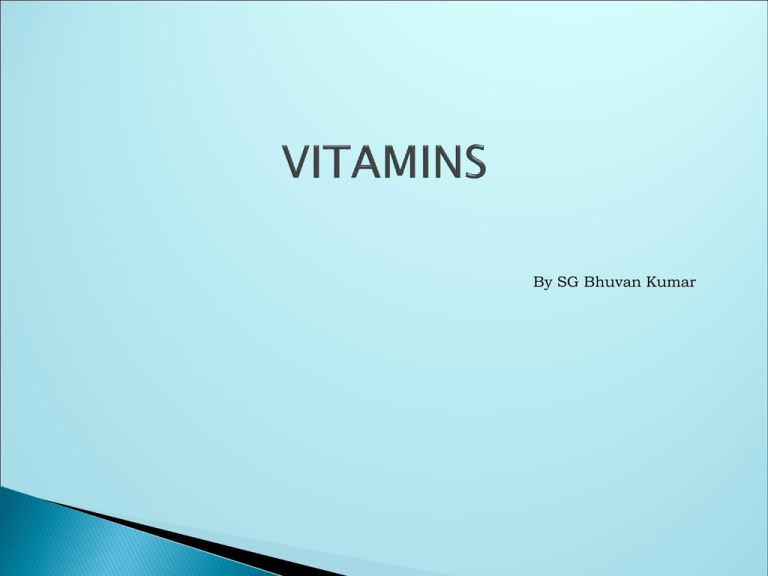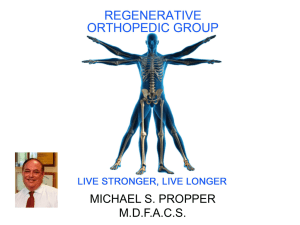
By SG Bhuvan Kumar
VITAMINS - deficiency diseases
History of vitamins :
The story of vitamin dates back to 18th
century.
Sailors of this period knew that eating of liver
cures a disease called night blindness
and
Eating of lemons cures another disease called
scurvy.
Also cod liver oil cures a disease called
rickets
In 1912, Sir H.G. Hopkins first identified Vitamins in
MILK and named it as Accessory factors.
Funk named the accessory factors as Vitamins
(Vital amines).
Vitamins are micronutrients, which are very much
essential for growth and for metabolism.
If antibiotics are indiscriminately taken, the
bacteria present in the intestines which
synthesize the Vitamins will be killed and it
leads to Vitamin deficiency disorders
Vitamins are classified into two types – based
on their solubility .
They are -
Water soluble vitamins & Fat soluble vitamins.
Water soluble Vitamins - Vitamin ‘B’ complex and
Vitamin ‘C’
Fat soluble vitamins. - Vitamin A, Vitamin D,
Vitamin E and Vitamin K
Water soluble vitamins
Vitamin B Complex is group of Vitamins.
It contains –
a) Thiamine – B1
b) Riboflavin – B2
c) Niacin
- B3
d) Pyridoxine – B6
e) Cyanocobalamin – B12
f) Folic acid
g) Pantothenic acid
h) Biotin
Vitamin –B1 - Thiamine is also known as
Vitamin B1.
It is needed for the activity of some of the
enzymes of carbohydrate metabolism.
Deficiency disease - Beri-Beri.
In this disease, the calf muscles become tender,
vomiting, tremors, convulsions, loss of appetite are
seen.
Sources: Cereals like wheat, oil seeds like
groundnut, milk, meat, fish.
RIBOFLAVIN -
Riboflavin is otherwise known as Vitamin-B2.
Functions: Riboflavin is essential for oxidation reduction reactions in the
cell and in cellular respiration.
Sources: It is present in milk, eggs, liver, kidney and green leafy
vegetables.
Deficiency disorders: Deficiency of riboflavin result in Glossitis
Mouth cracks at corners.
Photophobia, scaly skin and watering of eyes are some of the
symptoms.
NIACIN:
Niacin is one of the ‘B’ Complex Vitamins. It is also
known as Vitamin B3.
Functions: Niacin is essential for the metabolism of
carbohydrates, proteins and fats.
Sources: It is present in kidney, liver, meat, poultry
fish, legumes and groundnuts.
Deficiency disorders: Deficiency of niacin in diet
result a disease called Pellagra. The symptoms of
pellagra are diarrhea, dementia (loss of memory)
patches on the body when exposed to sunlight .
PYRIDOXINE:
Pyridoxine is otherwise called Vitamin-B6.
Functions: Pyridoxine plays an important role
in the metabolism of amino acids.
Sources: It is present in milk, liver, meat, egg
yolk, fish, cereals, legumes and
vegetables.
Deficiency disorders: Deficiency lead to hyper
irritability, anaemia, nausea and in children it
leads to convulsions.
Folic Acid :
Sources: It is present in liver, meat, eggs,
milk, fruits, cereals, and leafy vegetables over
cooking of food destroys the folic acid
Functions :
Folic acid is required for the synthesis of
nucleic acids (DNA and RNA).
It is also required for the development of
blood cells in the bone marrow.
Deficiency Symptoms: Its deficiency causes
anemia, diarrhoea and decrease in the
number of leucocytes.
Cell division in tissues such as intestinal
mucosa is affected in folic acid deficiency.
Cyano cobalamin: It is also known as vitamin B12.
Functions:
It plays an important role in the metabolism of
nucleic acid of protein synthesis.
Sources :
Bacteria present in the intestine synthesize this vitamin
and supply to our body.
Liver is the main site of storage of vitamin B12
Deficiency diseases :
Deficiency of this vitamin causes pernicious anemia that is
different from other types of anaemia.
It is one of the ‘B’ complex vitamins.
Functions: It is required for the metabolism of
carbohydrates, proteins and fats.
Sources: The sources of pantothenic acid are fresh
vegetables, liver, kidney, yeast, egg yolk, meat, ground
nuts etc.
Deficiency leads to burning sensation in feet
Biotin is one among the ‘B’ complex vitamins.
Functions: It is required for protein metabolism.
Sources: Biotin is present in pulses, nuts,
vegetables, liver and kidney.
Deficiency disorders: Deficiency leads to
muscle pains, fatigue, disorders in the nervous
system and mental depression.
Vitamin C – It is also called as Ascorbic Acid
Sources: Vitamin C is present in fresh fruits, green leafy vegetables,
tomatoes
and germinating pulses.
Citrus fruit and Indian gooseberry are the richest source of this
vitamin.
Guava is another cheap and rich source of Vitamin C.
Functions
Vitamin C plays an important role in tissue oxidation reactions.
It is required for the formation of collagen which is required for the
formation of blood vessels, connective tissue, cartilage and dentine
of teeth.
Vitamin C also helps in the absorption and storage of iron.
This Vitamin is also required for normal growth, tissue repair, healing
of wounds and fracture of bone.
Deficiency disease - SCURVY:
Scurvy is the nutritional disorder caused due
to the deficiency of Vitamin ‘C’.
The symptoms of this disease are swelling of
gums, bleeding from gums and from the
joints and under the skin.
This disease is preventable by providing the
diet that is rich with Vitamin-‘C’.
vitamin - A
Vitamin – D
Vitamin – E
Vitamin - K
Vitamin - A
The chemical name of Vitamin A is Retinol.
It is also called as Antixeropthalmic Vitamin
Sources - It is readily available in foods of
Liver, eggs, butter, whole milk, fish, meat,
oils extracted from fishes such as cod liver oil
and shark liver oil.
In plants vitamin ‘A’ is present in the form of
a carotene. In green leafy vegetable (Spinach
amaranth etc.,) other vegetable like carrots,
tomato, pumpkin, fruits like papaya and
mango and its converted into vitamin ‘A’ in
our body.
Deficiency of vitamin A:
of the eyes and this
Deficiency leads to a variety of disorders
affect the vision, some of the disorders are –
1)Night blindness: The person cannot see the objects in dim
light and in nights.
2)Xeropthalmia (or) Dry eyes: The lacrimal
glands in the eyes do to produce tears.
The conjunctiva (or) the outer most layer of the eye becomes
dry
3)The cornea becomes soft and burst open. This leads to the loss of vision
and permanent blindness - the major cause of blindness in children.
4)Skin become scaly, rough and is covered with papillae (Small eruptions).
The skin looks like that
of a toad.
5)Reproductive functions may also be effected in vitamin ‘A’ deficiency.
National Institute of Nutrition, Hyderabad has evolved a method giving a large dose
(5 – 6 drops) of Vitamin-A once in six months to prevent blindness in children
Vitamin ‘D’The chemical name of vitamin ‘D’ is Calciferol
Function - It helps in the absorption of Ca & P by the intestine and
its deposition on the bones.
The rich source of Vitamin ‘D’ is sun light and sun light has the
capacity to convert cholesterol in our body into Vitamin ‘D’.
Deficiency of vitamin ‘D’ leads to bone deformities
such as Rickets. (bent bones and knock knees)
Sources Vitamin ‘D’ present in foods of animal origin such as liver, egg
yolk, butter, oils extracted from the livers of fishes such as cod or
shark.
It is formed in the skin from a cholesterol derivative by the action
of Ultra Violet rays of sunlight
VITAMIN-E
Vitamin-E is also called as Tocoferol or Anti sterility Vitamin.
Functions: This vitamin is required for the normal
functioning of sex organs.
Sources: It is present in fruits, vegetables, germinating
seeds, meat, egg yolk, sunflower
oil, cotton seed oil etc.,
Deficiency disorders: Deficiency leads to sterility in males
and abortions in females and
also reduces the life
span or R.B.C.
VITAMIN-K
Vitamin K is also known as Anti coagulation
Vitamin.
Functions: It is required for blood clotting.
Sources: It is present in green leafy
vegetables and in cow milk, in man this
vitamin is synthesized by the bacteria
present in the intestines.
Deficiency disorders: deficiency results in
long time for the blood to
clot and loss
of more blood from injuries
Vitamins are very sensitive to heat. Over
cooking leads to destruction of its chemical
nature and some times leads toxic.
Excess intake of antibiotics, destroy useful
bacteria in our intestine, further leads to
vitamin B 12 deficiency.
Consuming highly polished rice, leads to
vitamin B1 deficiency.







